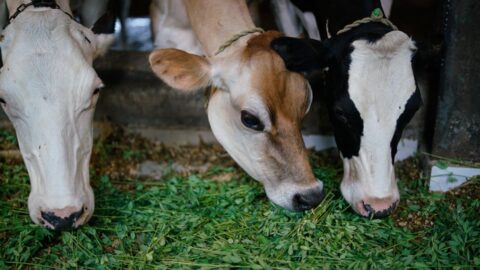Drive-by Extinction
The author of today’s post, Lisa Moore, Ph.D., is a scientist in the Climate and Air program.
Last weekend’s Mercury News ran a news story about vehicle emissions harming native species in California. The excess nitrogen from vehicle emissions caused invasive species to displace the plants that feed the bay checkerspot butterfly, which is threatened with extinction. My friend and colleague Dr. Stuart Weiss, the scientist who uncovered the link, calls this "drive-by extinction".
Nitrogen pollution has profound effects on life, health, and climate, yet these go mostly unnoticed by policymakers and the public.

Nitrogen and Ecosystems
Burning fossil fuels releases nitrogen oxides – compounds of nitrogen and oxygen that are collectively known as "NOx". Rain washes nitrogen from the atmosphere, but it also can settle to the ground in dry form. Scientists call this "nitrogen deposition".
Nitrogen’s ecological impact is large because it’s essential for life but scarce. Until people started burning fossil fuels and using fertilizer, the nitrogen cycle was ruled by soil bacteria, which pull nitrogen from the atmosphere and make it available to plants, and respire it back into the atmosphere. Species and ecosystems evolved to function on the small amount of nitrogen that was available.
Human-caused nitrogen deposition has greatly increased the amount of nitrogen added to the Earth’s surface each year, with wide-ranging impacts. (See the "The Nitrogen Cascade [PDF]" for a good overview.) Some plants are more sensitive to nitrogen than others, and the species that grow more can displace other species. Unfortunately for the bay checkerspot butterfly, the displaced species was its main food source. And it’s not the only casualty. In his report "Impacts of Nitrogen Deposition on California Ecosystems and Biodiversity [PDF – 7MB]", Dr. Weiss shows that hundreds of California’s rare plant and animal species live in deposition hotspots.
Nitrogen and Public Health
The NOx emitted from tailpipes and smokestacks also damages health. Environmental Defense has put together a fact sheet outlining the problem [PDF], and an in-depth look at the problem in New York City [large PDF].
The damage comes from multiple directions. The NOx gas nitrogen dioxide (NO2) is a lung irritant that also increases susceptibility to infection. Plus, NOx gases combine with ammonia in the atmosphere to form ammonium nitrate – an important component of fine particulate matter that inflames blood vessels and increases the risk of heart attack and stroke. And that’s not all. NOx gases are precursors to ground-level ozone (smog), a lung irritant that aggravates asthma, and can cause premature death.
Nitrogen and Climate
As I explained in my post "Ozone Alert For Plants", the same chemical reactions that form unhealthy smog also increase levels of tropospheric ozone, a greenhouse gas. So nitrogen contributes to global warming in that way – but that’s not all.
Use of fertilizers is another major source of nitrogen. Producing synthetic fertilizer is energy intensive, and so produces greenhouse gases. Plus, only a fraction of the nitrogen supplied by the fertilizer will be taken up by crops. Some of what’s wasted is washed into streams where it contaminates drinking water and causes coastal dead zones. Soil bacteria convert the remainder into gas – including the highly potent greenhouse gas nitrous oxide – which escapes back to the atmosphere.
What Can We Do?
We have the technology to cut NOx emissions from power plants – we just need to do it. Measures to reduce traffic congestion also can make a big difference. Farmers can decrease the amount of fertilizer they use, without affecting crop yields. A study in Mexico found that farmers could decrease nitrous oxide emissions 95 percent, using 28 percent less fertilizer, just by changing when they added it to their fields. Environmental Defense is working with farmers in the Mid-Atlantic and Midwest to use fertilizers more efficiently.
Nitrous oxide is a large slice of the greenhouse gas pie, so we need to pay attention to it. And as the bay checkerspot butterfly reminds us, cutting nitrogen pollution for the climate’s sake will bring many other benefits.












2 Comments
Thankyou for reminding us that there are noxius gasses other than carbon dioxide that require our social conscious. Hydrocarbons, Carbon Monoxide, and Nitrogen Oxides have been regulated in the automotive industry now for almost 30 years. Unfortunately, the measures used to reduce these gasses in automobiles do so at the expense of increased carbon dioxide. I was beginning to wonder if new federal mandates were going to require us to remove our catalytic converters and EGR valves to reduce greenhouse gasses.
You make a very good point about industry not being regulated proportionately with the automotive industry. American drivers have spent countless billions in increased automotive component costs and repair, as well as periodic emissions inspections. Why are industrial smokestacks not subject to similar regulation, while the automobile is still vilified? Why is fertilizer use not subject to the same inspection criteria as the many millions of automobiles?
Thankyou, also for calling to our attention the large impact nitrogen oxides have on global warming. Until I read this article, I had previously thought that by far the largest cause of global warming was water vapor, and secondarily carbon dioxide, and that tertiary contributors were small in comparison. I had no idea that nitrogen oxides played such a large part of the problem!
Hey folks, here’s one more example of nitrogen pollution that’s often overlooked: hog farming, which can release nitrogen into the air and water. Environmental Defense’s Raleigh office is working hard to clean up hog farming in North Carolina.